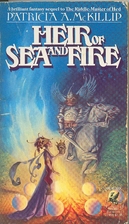It’s the last day of the year, so I think it’s safe to say I won’t be finishing any of my pending reads before midnight. I can therefore present to you the completed list of books I read in 2009:
- 73. Harpist in the Wind – Patricia A. McKillip
- 72. Heir of Sea and Fire – Patricia A. McKillip
- 71. Obernewtyn – Isobelle Carmody
- 70. Labyrinth – Kate Mosse
- 69. The Rest Falls Away – Colleen Gleason
- 68. The Gates of Sleep – Mercedes Lackey
- 67. Mirrormask – Neil Gaiman and Dave McKean
- 66. Blood Debt – Tanya Huff
- 65. Daughter of Venice – Donna Jo Napoli
- 64. Jane Austen Ruined My Life – Beth Pattillo
- 63. The Lives of Christopher Chant – Dianna Wynne Jones
- 62. Charmed Life – Dianne Wynne Jones
- 61. Magic and the Modern Girl – Mindy Klasky
- 60. Slam – Nick Hornby
- 59. Hanging out with the Dream King – Joseph McCabe
- 58. Dead as a Doornail – Charlaine Harris
- 57. Blood Pact – Tanya Huff
- 56. Tamsin – Peter Beagle
- 55. Mistress of the Art of Death – Ariana Franklin
- 54. Mister Monday – Garth Nix
- 53. The Bloody Chamber – Angela Carter
- 52. Night Shift – Lilith Saintcrow
- 51. The Privilege of the Sword – Ellen Kushner
- 50. Something Rich and Strange – Patricia A. McKillip
- 49. The Professor and the Madman – Simon Winchester
- 48. Dead to the World – Charlaine Harris
- 47. Elvenblood – Andre Norton and Mercedes Lackey
- 46. Off the Tourist Trail – Eyewitness Travel
- 45. Coraline – Neil Gaiman
- 44. Winter Rose – Patricia A. McKillip
- 43. Cloud Atlas – David Mitchell
- 42. The Writer’s Journey – Christopher Vogler
- 41. The Hollow Chocolate Bunnies of the Apocalypse – Robert Rankin
- 40. The Crow – Alison Croggon
- 39. M is for Magic – Neil Gaiman
- 38. Fingersmith – Sarah Waters
- 37. A Killer Stitch Maggie Sefton
- 36. Maui – Robert Nilsen
- 35. 101 Things You Didn’t Know About Jane Austen – Patrice Hannon
- 34. A Canticle for Leibowitz – Walter M. Miller Jr.
- 33. The Private Diary of Mr. Darcy – Maya Slater
- 32. Blood Lines – Tanya Huff
- 31. Bound – Donna Jo Napoli
- 30. The Elvenbane – Andre Norton and Mercedes Lackey
- 29. Harlequin Valentine – Neil Gaiman
- 28. Earth Abides – George A. Stewart
- 27. Pride and Prejudice and Zombies – Seth Grahame-Smith
- 26. The City of Ember – Jeanne DuPrau
- 25. Spiral Hunt -Margaret Ronald
- 24. The Nibelungenlied
- 23. The Historian – Elizabeth Kostova
- 22. Fortune’s Fool – Mercedes Lackey
- 21. The Forgotten Beasts of Eld – Patricia A. McKillip
- 20. Elegant Enigmas: The Art of Edward Gorey – Karen Wilkin
- 19. Wastelands: Stories of the Apocalypse – John Joseph Adams, ed.
- 18. Reserved for the Cat – Mercedes Lackey
- 17. Princess Academy – Shannon Hale
- 16. The Snow Queen – Mercedes Lackey
- 15. The Dreaming Place – Charles de Lint
- 14. Atonement – Ian McEwan
- 13. Reading the OED – Ammon Shea
- 12. Inkspell – Cornelia Funke
- 11. The Voyage of the Dawn Treader – C S Lewis
- 10. The Yiddish Policemen’s Union – Michael Chabon
- 9. The Birchbark House – Louise Erdrich
- 8. Breaking Dawn – Stephenie Meyer
- 7. Boston Curiosities – Ted Clarke
- 6. Club Dead – Charlaine Harris
- 5. At Death’s Door – Jill Thompson
- 4. The Riddle-Master of Hed – Patricia A. McKillip
- 3. Sorcery & Cecilia or The Enchanted Chocolate Pot – Patricia A. Wrede and Caroline Stevermer
- 2. Eclipse – Stephanie Meyer
- 1. Sword and Sorceress XII – Marion Zimmer Bradley

















